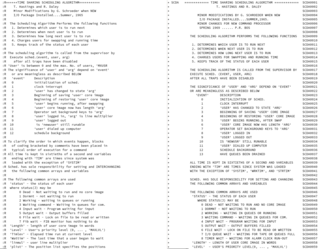
The Electronic Delay Storage Automatic Calculator (EDSAC) was an early British computer. Inspired by John von Neumann's seminal First Draft of a Report on the EDVAC, the machine was constructed by Maurice Wilkes and his team at the University of Cambridge Mathematical Laboratory in England. EDSAC was the second electronic digital stored-program computer to go into regular service.

A wargame is a strategy game in which two or more players command opposing armed forces in a simulation of an armed conflict. Wargaming may be played for recreation, to train military officers in the art of strategic thinking, or to study the nature of potential conflicts. Many wargames re-create specific historic battles, and can cover either whole wars, or any campaigns, battles, or lower-level engagements within them. Many simulate land combat, but there are wargames for naval and air combat, as well.

The IBM 7090 is a second-generation transistorized version of the earlier IBM 709 vacuum tube mainframe computer that was designed for "large-scale scientific and technological applications". The 7090 is the fourth member of the IBM 700/7000 series scientific computers. The first 7090 installation was in December 1959. In 1960, a typical system sold for $2.9 million or could be rented for $63,500 a month.

The IBM 709 is a computer system that was initially announced by IBM in January 1957 and first installed during August 1958. The 709 was an improved version of its predecessor, the IBM 704, and was the third of the IBM 700/7000 series of scientific computers. The improvements included overlapped input/output, indirect addressing, and three "convert" instructions which provided support for decimal arithmetic, leading zero suppression, and several other operations. The 709 had 32,768 words of 36-bit magnetic core memory and could execute 42,000 add or subtract instructions per second. It could multiply two 36-bit integers at a rate of 5000 per second.

The IBM 700/7000 series is a series of large-scale (mainframe) computer systems that were made by IBM through the 1950s and early 1960s. The series includes several different, incompatible processor architectures. The 700s use vacuum-tube logic and were made obsolete by the introduction of the transistorized 7000s. The 7000s, in turn, were eventually replaced with System/360, which was announced in 1964. However the 360/65, the first 360 powerful enough to replace 7000s, did not become available until November 1965. Early problems with OS/360 and the high cost of converting software kept many 7000s in service for years afterward.
The Multiface was a hardware peripheral released by Romantic Robot for several 1980s home computers. The primary function of the device was to dump the computer's memory to external storage. Pressing a red button on the Multiface activated it. As most games of the era did not have a save game feature, the Multiface allowed players to save their position by saving a loadable snapshot of the game. Home computer software of the early 1980s was typically loaded into RAM in one go, with copy protection measures concentrating the loading phase or just after it. The snapshot feature could be used after copy protection routines had been executed, to create a backup that was effectively unprotected against unauthorised distribution. Later models of the Multiface mitigated this by requiring the device to be present when re-loading the dumps into memory, making the dumps useless to people without a Multiface. Software producers also reacted to the threat by using routines that would prevent execution of the product if it detected that a Multiface was present and by loading the software in multiple parts, thus requiring the presence of the original, copy-protected media.

In computing, PEEK and POKE are commands used in some high-level programming languages for accessing the contents of a specific memory cell referenced by its memory address. PEEK gets the byte located at the specified memory address. POKE sets the memory byte at the specified address. These commands originated with machine code monitors such as the DECsystem-10 monitor; these commands are particularly associated with the BASIC programming language, though some other languages such as Pascal and COMAL also have these commands. These commands are comparable in their roles to pointers in the C language and some other programming languages.

The Compatible Time-Sharing System (CTSS) was the first general purpose time-sharing operating system. Compatible Time Sharing referred to time sharing which was compatible with batch processing; it could offer both time sharing and batch processing concurrently.

Core War is a 1984 programming game created by D. G. Jones and A. K. Dewdney in which two or more battle programs compete for control of a virtual computer. These battle programs are written in an abstract assembly language called Redcode. The standards for the language and the virtual machine were initially set by the International Core Wars Society (ICWS), but later standards were determined by community consensus.
A digital organism is a self-replicating computer program that mutates, reproduces, and evolves. Digital organisms are used as a tool to study the dynamics of Darwinian evolution, and to test or verify specific hypotheses or mathematical models of evolution. The study of digital organisms is closely related to the area of artificial life.

A ROM image, or ROM file, is a computer file which contains a copy of the data from a read-only memory chip, often from a video game cartridge, or used to contain a computer's firmware, or from an arcade game's main board. The term is frequently used in the context of emulation, whereby older games or firmware are copied to ROM files on modern computers and can, using a piece of software known as an emulator, be run on a different device than which they were designed for. ROM burners are used to copy ROM images to hardware, such as ROM cartridges, or ROM chips, for debugging and QA testing.

Victor Alexander Vyssotsky was a mathematician and computer scientist. He was the technical head of the Multics project at Bell Labs and later executive director of Research in the Information Systems Division of AT&T Bell Labs. Multics, whilst not particularly commercially successful in itself, directly inspired Ken Thompson to develop Unix. Later, Vyssotsky was the founding director of Digital's Cambridge Research Lab.
In video games, artificial intelligence (AI) is used to generate responsive, adaptive or intelligent behaviors primarily in non-playable characters (NPCs) similar to human-like intelligence. Artificial intelligence has been an integral part of video games since their inception in the 1950s. AI in video games is a distinct subfield and differs from academic AI. It serves to improve the game-player experience rather than machine learning or decision making. During the golden age of arcade video games the idea of AI opponents was largely popularized in the form of graduated difficulty levels, distinct movement patterns, and in-game events dependent on the player's input. Modern games often implement existing techniques such as pathfinding and decision trees to guide the actions of NPCs. AI is often used in mechanisms which are not immediately visible to the user, such as data mining and procedural-content generation.
In computing, channel I/O is a high-performance input/output (I/O) architecture that is implemented in various forms on a number of computer architectures, especially on mainframe computers. In the past, channels were generally implemented with custom devices, variously named channel, I/O processor, I/O controller, I/O synchronizer, or DMA controller.

Kriegsspiel is a genre of wargaming developed by the Prussian Army in the 19th century to teach battlefield tactics to officers. The word Kriegsspiel literally means "wargame" in German, but in the context of the English language it refers specifically to the wargames developed by the Prussian army in the 19th century. Kriegsspiel was the first wargaming system to have been adopted by a military organization as a serious tool for training and research. It is characterized by high realism, an emphasis on the experience of decision-making rather than on competition, and the use of an umpire to keep the rules flexible and manage hidden information. After Prussia's impressive victory over France in the Franco-Prussian War, other countries began designing similar wargames for their own armies.
Cheating in video games involves a video game player using various methods to create an advantage beyond normal gameplay, usually in order to make the game easier. Cheats may be activated from within the game itself, or created by third-party software or hardware. They can also be realized by exploiting software bugs; this may or may not be considered cheating based on whether the bug is considered common knowledge.
The history of IBM mainframe operating systems is significant within the history of mainframe operating systems, because of IBM's long-standing position as the world's largest hardware supplier of mainframe computers. IBM mainframes run operating systems supplied by IBM and by third parties.

In computing, an emulator is hardware or software that enables one computer system to behave like another computer system. An emulator typically enables the host system to run software or use peripheral devices designed for the guest system. Emulation refers to the ability of a computer program in an electronic device to emulate another program or device.

In computing TMG (TransMoGrifier) is a recursive descent compiler-compiler developed by Robert M. McClure and presented in 1965. TMG ran on systems including OS/360 and early Unix. It was used to build EPL, an early version of PL/I.













